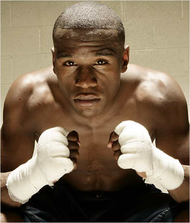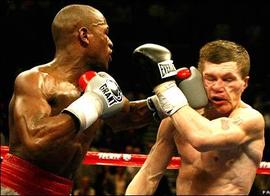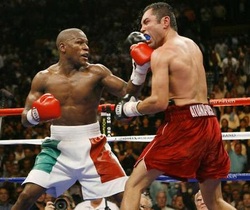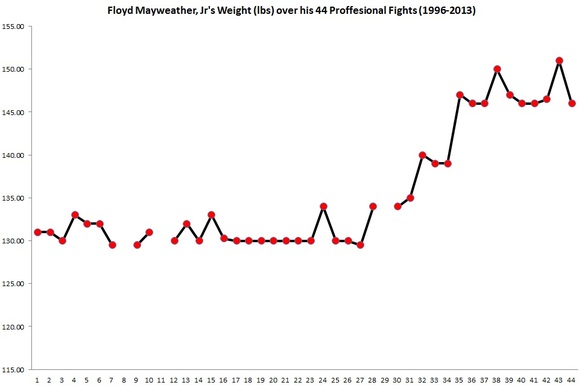 Floyd 'Money' Mayweather, Jr
Floyd 'Money' Mayweather, Jr On the 14th of September, Floyd Mayweather Jr will take on Saul Alvarez at the MGM Grand, Las Vegas, Nevada at a catchweight limit of 152lbs. The fight is major box office business and to the general public the weight limit of the fight is of little consequence. To Floyd Mayweather Jr the fight at a catchweight is indicative of his decision-making in the latter part of his career.
Floyd Mayweather jr is undoubtedly the elite boxer of his generation as he is undefeated after 44 professional bouts and was the highest paid athlete according to Forbes in 2012, earning a reported $85 million (knocking Tiger Woods off the top earners spot for the first time since 2002). Added to this, he was involved in the biggest Pay Per View of all time in 2007 when he fought Oscar De La Hoya.
While Mayweather’s decisions in his personal life have recently landed him in prison, when it comes to making decisions in the ring, concerning which opponent to take on, he is the shrewdest operator of them all. His choices here have allowed him to surpass his peers and have cemented his legacy as an undoubted future Hall of Famer.
Boxing is of interest to economists and decision theorists as there is no other sport with a comparable competitive structure to it. Boxing has no central governing body, there is no set league or competition and no set future schedule. What it has is a number of governing organisations, each with their own belts in each weight division. The problem with such a structure is that fighters may not end up fighting the best available opponent. A singular weight division for example can have numerous legitimate world champions at any one time (IBF, WBC, WBA and WBO are all considered the most legitimate governing bodies but there is a number of others including WBF and IBO). Champions then have to defend their belts against mandatory challengers within their organisation or risk losing their 'world champion' status. Champions in a singular weight division however, do not end up facing each other, mainly due to organisations having different rankings and for the fear that defeat could mean a downward trend in a fighter’s career and in some cases, the end of a career.
If a team or individual lose in another sport it is often looked upon as a reason to come back stronger. Boxing however, due to the explicit physical dangers, is different. A fighter carries a high cost if defeated. It is not unusual if a fighter is defeated for many to question their ability to continue (certainly at the level they are defeated).Decisions on opponents are therefore all the more important and it has become a highly strategic game.
But this is only one blade of the scissors; the economics of a fight is essential for it to go ahead also. The success of bouts is dependent on the interest the public take in the fight. No matter how talented a fighter is, it will not necessarily mean they will be financially successful. The market truly decides on whether a fighter will be financially successful or not.
Thus to have a successful career you not only need the ability but you must tick both the boxes of choosing wisely over opponents and meeting the market’s needs, something Floyd Mayweather excels at.
Mayweather’s impressive record is in no small part due to his decision-making where he evaluates his position in the market and the abilities of his opponent. The risks of fighting remain the same for every boxer but what Mayweather has done particularly well in the latter half of his career is make calculated risks and chosen opponents whereby most of his challengers have to leave their ‘comfort zone’ while he remains in his. Mayweather understands that having that zero on his record allows him to earn more than any other fighter. Boxers, outside of the heavyweight division and local fighters, find it difficult to catch the general public’s imagination at the consistent level of other sports. Mayweather understands his undefeated status is a signal that allows him to stimulate interest amongst the general public and make more money through Pay Per View sales. On the flip side, he also understands a defeat would be detrimental to his earning potential. A good example of this was his decision not to fight Manny Pacquiao that was widely criticised.
 Mayweather - weighing in
Mayweather - weighing in For most fighters there is a positive correlation between their weight and number of fights. Weight increases as fighters get into the ring more. Mayweather is no different here (see below). When fighters are younger they can maintain a lower weight but as they age this becomes more difficult. Naturally they move up in
weight classifications. Mayweather has followed this trend with few deviations. Furthermore, It is generally accepted that fighters lose speed and may potentially not maintain their punching power as they go up through weight divisions fighting naturally bigger opponents. On the other hand, fighters may lose conditioning which effects their durability if they are forced to come down weightdivisions and fight opponents who are more natural at lighter weights.
 The 'Pretty Boy' in action
The 'Pretty Boy' in action His next opponent was Ricky Hatton. This fight was at welterweight,
Mayweathers optimum weight. Hatton had only fought as high as light welterweight (140lbs) before this fight. Mayweather won by impressive TKO in round 10.
The following bout was against Juan Manuel Marquez. Again the fight was at welterweight. Marquez had previously fought as high as junior welterweight but many would argue lightweight was his optimum weight (135lbs). Mayweather won an easy unanimous decision.
Following this he took on Shane Mosley, again at welterweight. Like the De La Hoya fight, the decision to fight Mosley was calculated. Mosley was campaigning at welterweight but was in his 39th year and had fought at a higher weight some four years earlier. He also had five defeats on his record by the time he stepped into the ring. Mayweather won an easy unanimous decision.
Mayweather won his next bout against Victor Ortiz with a 4th round KO in controversial fashion. Again, Ortiz had only fought once at welterweight and had mainly campaigned as a light welterweight in the previous years.
Perhaps Mayweathers biggest risk in recent years was moving up to light middleweight for the first time since fighting De La Hoya for his fight with Miguel Cotto. His classed showed over twelve rounds with a unanimous decision victory over Cotto.
The most recent bout of Mayweather was against Robert Guerrero at welterweight once more. Guerrero, while fighting at welterweight twice was only three bouts previous campaigning at lightweight (135lbs).
So what’s next for Floyd?
 Mayweather vs. De La Hoya
Mayweather vs. De La Hoya This is, in my opinion, why Floyd Mayweather Jr is the undefeated fighter he is. He never has to push his body beyond its limits to meet weight limits. His opponents more often than not, do. Since his 2005 fight against Sharmba Mitchell, Mayweather has fought at welterweight with only two exceptions, Cotto and De La Hoya. His ability and undefeated status has allowed him the bargaining power to stay within his preferred weight category, removing a variable that could potentially damage his chances of success. His opponents however often do not fight in their preferred weight division. In addition, the comfort zone of Maywether is extended to only fighting in Las Vegas since 2006 which happens to be his city of residence.
Perphaps the take home message is that boxing at an elite level leaves very little room for error. A sport like boxing, unlike others, affords fighters the opportunity to choose opponents. Because of this and the due to the high price of loss, fighter must do a cost-benefit analysis like very few other athletes. Floyd Mayweather Jr and his team have perfected this.
This was a guest contribution by Gary Burns - Gary holds a degree in economics and has made various contributions both to print and online media on Boxing

 RSS Feed
RSS Feed